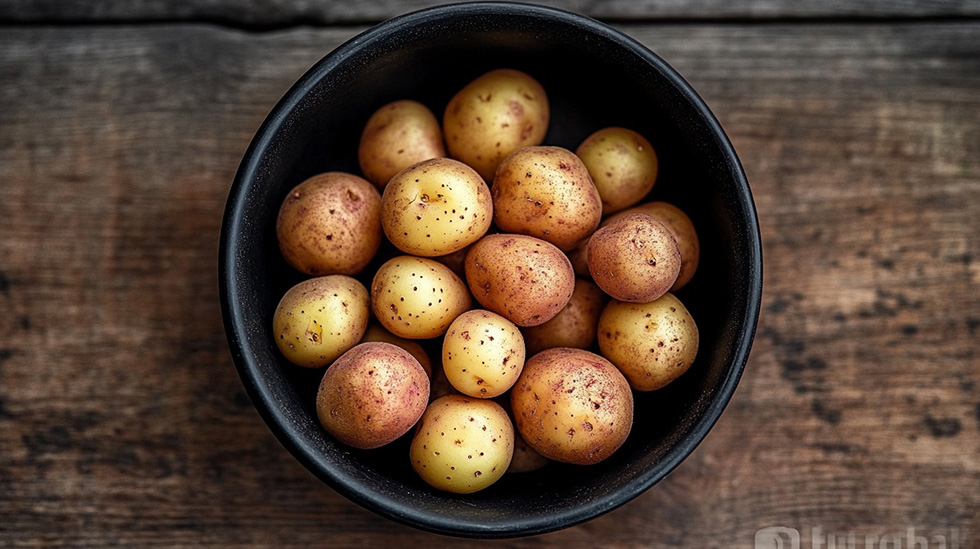Baby potato – The bite-sized delicacy you can’t help but love
Baby potatoes are a real culinary delicacy that simply cannot be left out of summer and autumn menus. Its tiny size, creamy texture and rich, slightly sweet flavour make it one of the gastronomy world’s secret weapons – and fortunately not so secret, as it is appearing regularly on the kitchen counter in more and more households.

Baby potato is a small, young potato, typically eaten with its skin on. In Latin, it belongs to the Solanum tuberosum family, as do the other potato species.
In other words, there is no official ‘baby potato’ variety, the name refers to its size and use. Usually new potatoes or potatoes with very small tubers are selected for this category. It is characterised by a thin skin, often reddish or golden yellow, and yellow or light yellow flesh. When cooked, they remain creamy soft but firm, making them ideal for grilling, baking or even cooking.
How is it different from other potatoes?
- Red potato: Also often used as a jacket potato, but usually larger in size, with a stronger skin and a sweeter flavour.
- Yellow potatoes: larger in size, firmer in texture, crispier when baked, but not as creamy.
- New potatoes: first on the market in spring, not yet fully ripe, with a very thin skin. New potatoes are similar, but are often harvested later, in the middle or at the end of the season, and the small tubers are carefully selected.
How important is it in the kitchen?
Importance: 5/5 – Baby potatoes are the Jolly Joker in the kitchen. Because it’s quick to prepare, has a special taste and is loved by almost everyone, it’s both practical and special. It can be a side dish, a salad base or even a main course – it’s brilliant on the barbecue, in the pan or in the oven.
Which parts are edible and which are not?
Of course, we eat the tubers of the potatoes – peeled! In fact, one of its main attractions is that it doesn’t need to be peeled: its thin skin crisps up when roasted, giving it extra flavour. However, its leaves, flowers and green shoots are poisonous, as they contain solanine, which can cause stomach upset or, in worse cases, poisoning. Do not use greenish or damaged tubers – they may also contain solanine!
Health benefits
As well as being delicious, baby potatoes are also nutritious:
- Rich in vitamin C, which supports the immune system
- High in potassium, which helps cardiovascular health
- contains vitamins B1 and B6, which help the nervous system to function properly
- It has a positive effect on digestion due to its fibre content
It has also been used in traditional medicine to relieve heartburn and inflammatory complaints, mainly cooked or mashed.
Growing and season
Baby potatoes are most commonly grown in the open field, but greenhouse growing is also practised in small quantities. It is grown throughout Europe, with France, the Netherlands, Germany and Spain leading the way. It is also increasingly popular in Hungary, mainly in the southern lowland and western Hungarian regions.
The season lasts from late spring to mid-autumn, and you can find it in shops mostly between May and October. The summer months are the best time to buy locally sourced produce. In winter, however, there’s a good chance it’s imported, so it’s a good time to look for quality.
How to choose good quality baby potatoes
- Tyres should be of uniform size and have a smooth surface
- Avoid greenish, damaged or wrinkled pieces
- They should be firm to the touch, not soft or slimy
- The smell should be fresh, not musty or earthy
The smaller, the better – that’s the golden rule of parsnips!
Storage – what NOT to do!
Do not refrigerate, as the cold turns the starch into sugar, which makes it sweet but strangely rubbery. Store it in a cool, dark, airy place (such as a pantry or cellar) in a paper bag or canvas bag to prevent it from sprouting and rotting. Do not keep in plastic bags!
Baby potato in the world
In Spain and Portugal it is often grilled with olive oil and sea salt, in France it is paired with butter and parsley. In Anglo-Saxon countries, it is the base for cold salads known as “baby potato salad”. In Scandinavia, it’s braised with beer, while in Italy it’s roasted with rosemary and garlic – and of course, they don’t spare a little Parmesan 😉
An iconic recipe: rosemary baked potatoes with parsley
Ingredients:
- 1 kg of baby potatoes (preferably the same size)
- 2-3 sprigs fresh rosemary
- 4 cloves garlic
- 3 tablespoons olive oil
- coarse sea salt to taste
Preparation: Place the washed baby potatoes in a baking dish, peeled, drizzle with olive oil, sprinkle with crushed garlic and chopped rosemary, then season with salt.Bake in a preheated oven at 200°C for 30-35 minutes until crispy. A heavenly side dish with any meat or fish – or on its own!
Tips for use in the kitchen
- Don’t peel – the crust is crispy and full of flavour!
- Spices that suit it: rosemary, thyme, garlic, parsley, lemon peel
- What to avoid: not very harmonious with sweet, fruity flavours (e.g. pineapple, cinnamon)
- Marinating overnight in oil and spices before frying works wonders
Once you taste a perfectly baked baked potato, it’s guaranteed to be love at first bite 💛
